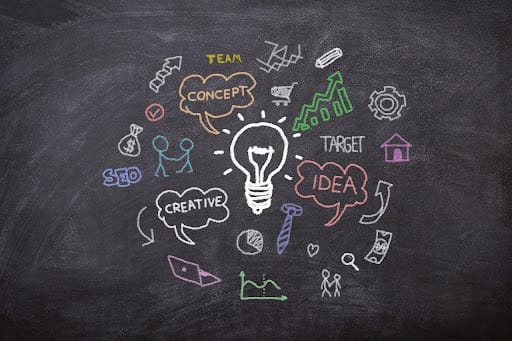At Fix & Form, we believe that everything begins with the way you think. This belief doesn’t just apply to personal growth—it’s foundational to building human-centered branding. The stories you tell yourself, the assumptions you make, and the mindset you operate from are the hidden architects of your outcomes. When you change your thinking, you shift your life—and your brand—with it.
Human-Centered Branding Begins with Thought
A strong, resonant brand isn’t just about visuals or taglines. It starts with people—what they think, feel, and believe. That’s why human-centered branding is built on a foundation of intentional thought. If the people behind the brand aren’t aligned mentally, emotionally, and creatively, the brand won’t connect with others either.
The Magnitude and Direction of Thoughts
Did you know the average person thinks over 30,000 thoughts per day? Your mind is constantly at work, processing and directing how you feel, behave, and ultimately, how you make decisions. That includes how you show up in your business and how your brand is experienced.
Consider this: a sunny thought might spark peace and joy, while a memory of a failed pitch could shift your mood and body language in seconds. These subtle shifts demonstrate the massive power our thoughts have on our lives—and on our brands.
Direction of Thought
At a conference earlier this year, someone asked our intern, “Do you like where your thoughts are taking you?” That simple question gets at the core of human-centered branding. Because every thought leads somewhere. Is it toward connection or disconnection? Growth or stagnation? If your internal narrative is holding you back, your brand may reflect that hesitation too.
Magnitude of Thought
Like the famous line from Despicable Me: “Vector! Both direction and magnitude!”—your thoughts not only move you in a direction, they also carry weight. A tiny belief like “I’m not creative” can weigh heavily if it shows up in every brainstorm, every pitch, every brand decision. Even seemingly small thoughts shape the way you build, lead, and communicate your brand.
Perceived Importance and Its Role in Branding
Our minds tend to amplify what feels urgent or emotionally charged. But what feels big isn’t always actually big. A minor mistake might feel overwhelming simply because you keep replaying it. In the context of branding, a misstep in messaging or a slow-growth period might feel massive—but only if you assign it unnecessary power.
Human-centered branding involves filtering these thoughts through a more balanced lens—recognizing what actually matters to your audience, and what might just be noise.
Behavior Follows Belief
If you believe your brand is uninspiring, your actions will mirror that. You’ll hesitate to show up, to innovate, to market boldly. But if you carry the thought, “Our brand helps people, and we’re proud of that,” your actions change. That belief shifts how you write your copy, pitch your services, and design your website.
At Fix & Form, we work with clients to realign these beliefs. Not just to make something “look good,” but to create brands that are deeply human, honest, and powerful. Human-centered branding starts on the inside—then gets expressed outward through design, language, and action.
Cognitive Bias and Branding
Let’s talk about Magnitude Bias, a cognitive bias that impacts both life and business. It’s the tendency to misjudge the significance of events based on their perceived size. In branding, this might look like chasing trends or flashy offers that seem valuable, while ignoring what actually drives long-term connection and loyalty.
Human-centered brands focus less on flashy distractions and more on authentic alignment. They understand that emotional resonance is more powerful than hype—and that clarity of message often outshines complexity.
Change Your Thinking, Evolve Your Brand
Changing your thinking isn’t about fake positivity. It’s about deliberate, strategic rewiring. Your thoughts influence your behavior, and your behavior shapes your brand. The more intentional you are about your internal dialogue, the stronger and more aligned your human-centered branding becomes.
Professional athletes like Wyndham Clark and Serena Williams have long preached the power of mindset. For Serena, 70% of her performance comes from her mental game. The same holds true in business. From startups to industry leaders, the brands that thrive are the ones led by people with clear, resilient, human-focused thinking.
How to Shift Your Thinking Toward Human-Centered Branding
- Notice Your Default Thoughts: Do you tell yourself your industry isn’t creative? That your brand isn’t “fun” enough to be exciting? These limiting beliefs restrict brand evolution. At Fix & Form, we help clients challenge those assumptions to uncover new potential.
- Adopt a Growth Mindset: A growth mindset, as explained by Dr. Paula J. Caproni, is the belief that your abilities can develop over time. When you bring this mindset to your brand, you stay open to learning, experimentation, and pivoting—all critical to human-centered branding.
- Surround Yourself with Possibility-Thinkers: The people you work with should stretch your vision. From your internal team to your creative partners, collaboration should be about pushing the brand forward, not just maintaining what’s “worked in the past.”
As you move into your next workday, pause to ask: What direction are my thoughts taking me—and my brand? Are they leading to connection, relevance, and authenticity? Or are they reinforcing limitations?
You have 30,000 thoughts a day. Let’s make more of them count.
Want to see how we help brands become more human-centered from the inside out? Connect with us here.



